Back to nature: the story of one family’s retreat into the Amazon forest to escape Covid
New film charts the journey of the Kichwa people deeper into the Ecuadorian Amazon and the lessons they drew from reconnecting with nature
16:52 The Return: a family reconnects with the Amazon as Covid threatens their village – video
Patrick Greenfield
@pgreenfielduk
Tue 6 Jul 2021 12.00 BST
As billions of people isolated around the world in 2020, villagers from Sarayaku , a Kichwa community in the Ecuadorian Amazon, headed deeper into the forest to escape the coronavirus pandemic. The journey, documented in a new short film called The Return, reaffirmed the bond the community has had with the forest for generations, protecting ancestors from missionaries, militias and emerging diseases such as measles and smallpox, as well as sustaining life.
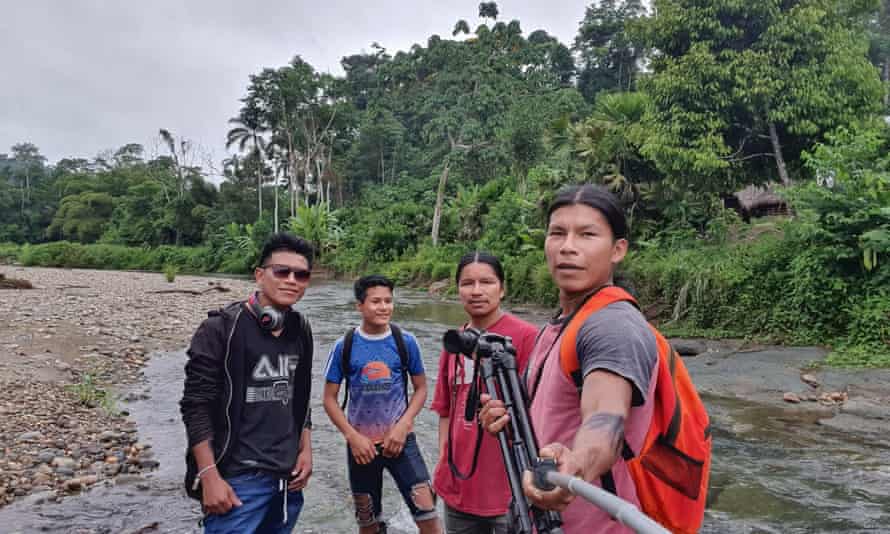
Eriberto with some of the crew and villagers in the Ecuadorian Amazon. Photograph: Selvas Producciones
Directed by the indigenous film-maker Eriberto Gualinga and co-produced by his niece and environmental defender Nina Gualinga, both from Sarayaku, alongside British film-maker Marc Silver, the Guardian documentary had its premiere at the Sheffield DocFest in June. The Kichwa community has gained international acclaim for its environmental activism, successfully defending its ancestral lands in the Bobonaza river basin against an oil company looking to drill, and winning a case against the Ecuadorian government at the Inter-American Court of Human Rights (IACHR) in 2012 for not respecting the right to life, safety and land.
The Guardian spoke with Eriberto and Nina about the message of The Return and their work as defenders of the forest.
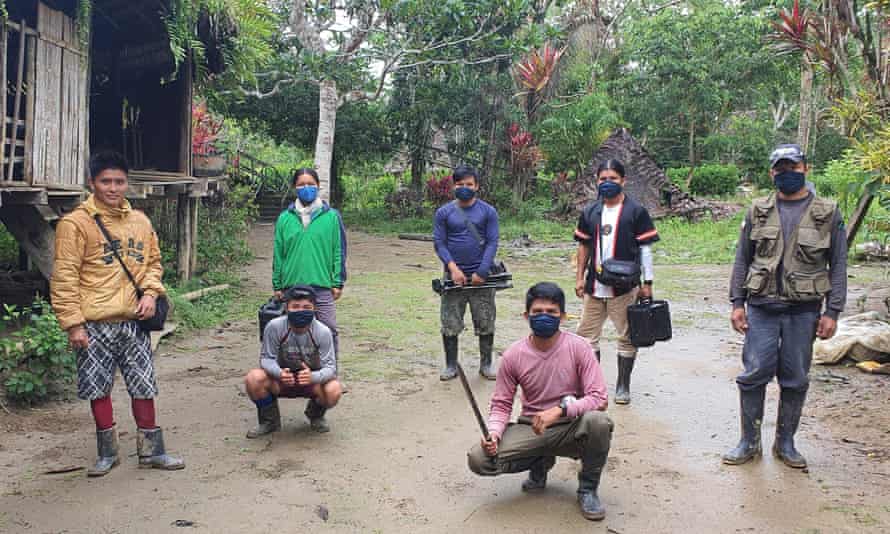
Directed by the indigenous film-maker Eriberto Gualinga and co-produced by his niece and environmental defender Nina Gualinga, both from Sarayaku, alongside British film-maker Marc Silver, the Guardian documentary had its premiere at the Sheffield DocFest in June. The Kichwa community has gained international acclaim for its environmental activism, successfully defending its ancestral lands in the Bobonaza river basin against an oil company looking to drill, and winning a case against the Ecuadorian government at the Inter-American Court of Human Rights (IACHR) in 2012 for not respecting the right to life, safety and land.
The Guardian spoke with Eriberto and Nina about the message of The Return and their work as defenders of the forest.

Eriberto and The Return crew filming in the Amazon. Photograph: Selvas Producciones
When did you realise the pandemic was coming?
Eriberto: “On 17 March 2020 there was terrible flooding in our village, Sarayaku, and other communities. It reached a height we’d never seen before, covering the roofs of homes and tearing down bridges. It left us with nothing, without food, nothing. We were reconstructing our homes and replanting crops when we heard on the radio that Covid had arrived in the nearest city. We’d already heard about the virus in February. When we were completely physically exhausted, Covid attacked us.”
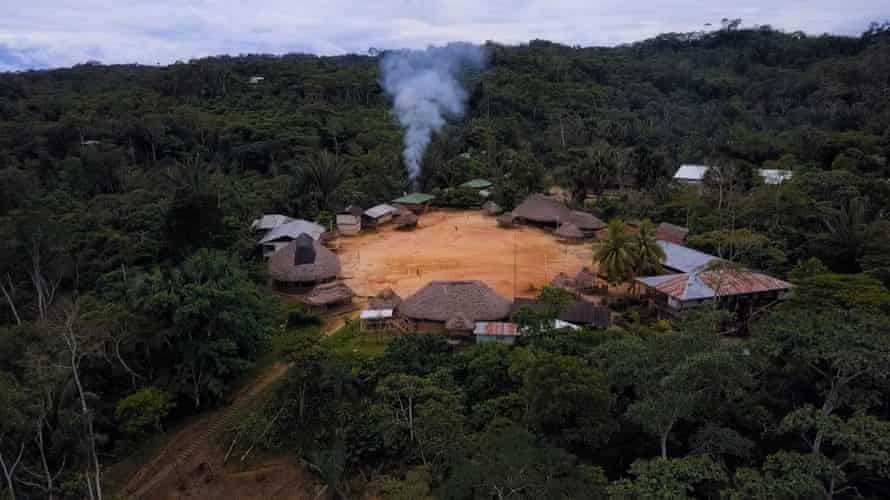
When did you realise the pandemic was coming?
Eriberto: “On 17 March 2020 there was terrible flooding in our village, Sarayaku, and other communities. It reached a height we’d never seen before, covering the roofs of homes and tearing down bridges. It left us with nothing, without food, nothing. We were reconstructing our homes and replanting crops when we heard on the radio that Covid had arrived in the nearest city. We’d already heard about the virus in February. When we were completely physically exhausted, Covid attacked us.”

The village lies in the middle of the Amazon forest in Ecuador. Photograph: Selvas Producciones
Some villagers headed deeper into the forest. Why did you want to document this journey?
Eriberto: “I wanted the world to also return to the forest. The forest is important. That is where life is. It is the lungs of the world. I imagined people isolating in the city in the pandemic – being stuck in four walls alone in a house – and all the problems that can bring.
Isolating in the forest is different. It is freedom, fishing, collecting fruit and medicinal plantsEriberto Gualinga
“Isolating in the forest is completely different. It is freedom, fishing, collecting fruit, long walks, sharing knowledge with parents, collecting medicinal plants … I wanted to show how important the forest is for the world and why we should reconnect with her. In Kichwa, the film is called Tiam which means ‘look back’. It’s about reconnecting with and respecting nature.”
In the film, it’s clear this is not the first time Kichwa community members have sought the protection of the forest.
Eriberto: “This is something our grandparents told us they and their ancestors did to escape the army, missionaries and illnesses such as measles and smallpox. Without making a noise, they’d confine themselves to the forest. They’d tell us about it as if it were a story, but it was reality, it actually happened. Now we’ve had to do it, too: escape to the middle of the forest, but evidently this time with technology by our side. The radio was telling us what was happening in the world.”
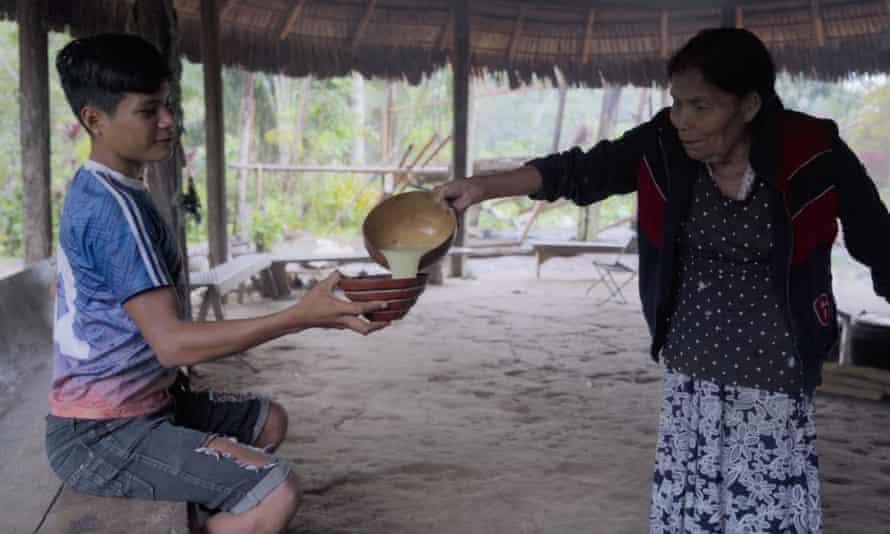
Some villagers headed deeper into the forest. Why did you want to document this journey?
Eriberto: “I wanted the world to also return to the forest. The forest is important. That is where life is. It is the lungs of the world. I imagined people isolating in the city in the pandemic – being stuck in four walls alone in a house – and all the problems that can bring.
Isolating in the forest is different. It is freedom, fishing, collecting fruit and medicinal plantsEriberto Gualinga
“Isolating in the forest is completely different. It is freedom, fishing, collecting fruit, long walks, sharing knowledge with parents, collecting medicinal plants … I wanted to show how important the forest is for the world and why we should reconnect with her. In Kichwa, the film is called Tiam which means ‘look back’. It’s about reconnecting with and respecting nature.”
In the film, it’s clear this is not the first time Kichwa community members have sought the protection of the forest.
Eriberto: “This is something our grandparents told us they and their ancestors did to escape the army, missionaries and illnesses such as measles and smallpox. Without making a noise, they’d confine themselves to the forest. They’d tell us about it as if it were a story, but it was reality, it actually happened. Now we’ve had to do it, too: escape to the middle of the forest, but evidently this time with technology by our side. The radio was telling us what was happening in the world.”

The family went further into the forest to isolate and seek safety as news of the spread of coronavirus reached the village. Photograph: Selvas Producciones
Sarayaku is a small village but its impact on the world has been mighty. What is it about people from Sarayaku?
Nina: “From the beginning, the Sarayaku people has been very clear with our vision for the future, our culture and our identity. We know what we are defending. I think that’s reflected in the decisions and creativity of young people, my uncle and myself. It’s not only Sarayaku, but I think the victory against the Ecuadorian government set a precedent internationally.”
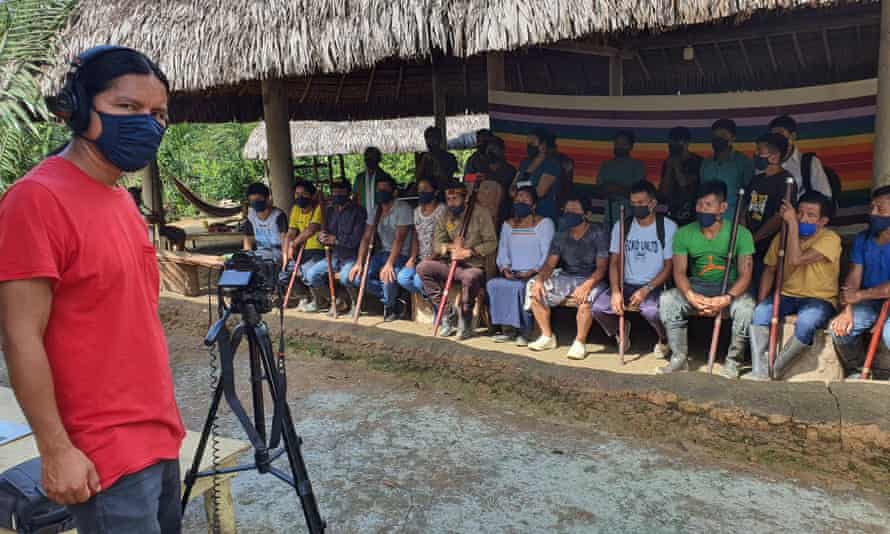
Sarayaku is a small village but its impact on the world has been mighty. What is it about people from Sarayaku?
Nina: “From the beginning, the Sarayaku people has been very clear with our vision for the future, our culture and our identity. We know what we are defending. I think that’s reflected in the decisions and creativity of young people, my uncle and myself. It’s not only Sarayaku, but I think the victory against the Ecuadorian government set a precedent internationally.”

Eriberto working behind the scenes with the Sarayaku people. Photograph: Selvas Producciones
Can you tell me about the Sarayaku’s living forest proposal, which seeks the protection of indigenous lands around the world?
Nina: “It’s very interconnected with what The Return is about and what it means. It’s a way to explain the indigenous view on how we as humans are part of this Earth, this living being, and all of these different ecosystems. It recognises life in the forest as a collective and individual: the plants, the trees, the stones, the spirits. That’s how Sarayaku understands the world.

Can you tell me about the Sarayaku’s living forest proposal, which seeks the protection of indigenous lands around the world?
Nina: “It’s very interconnected with what The Return is about and what it means. It’s a way to explain the indigenous view on how we as humans are part of this Earth, this living being, and all of these different ecosystems. It recognises life in the forest as a collective and individual: the plants, the trees, the stones, the spirits. That’s how Sarayaku understands the world.

‘I wanted to show how important the forest is for the world and why we should reconnect with her’ – Eriberto Gualinga. Photograph: Selvas Producciones
“The living forest proposal is about recognising that. And reframing the mechanisms we have constructed around us, such as laws and the economic system, to rethink what we actually value. Everything is recognised as a living being, beyond what our eyes can see in the Amazon rainforest and everywhere else. Perhaps it sounds complex and far away for many, but I think it’s really necessary right now.”
Find more age of extinction coverage here, and follow biodiversity reporters Phoebe Weston and Patrick Greenfield on Twitter for all the latest news and features
“The living forest proposal is about recognising that. And reframing the mechanisms we have constructed around us, such as laws and the economic system, to rethink what we actually value. Everything is recognised as a living being, beyond what our eyes can see in the Amazon rainforest and everywhere else. Perhaps it sounds complex and far away for many, but I think it’s really necessary right now.”
Find more age of extinction coverage here, and follow biodiversity reporters Phoebe Weston and Patrick Greenfield on Twitter for all the latest news and features
No comments:
Post a Comment